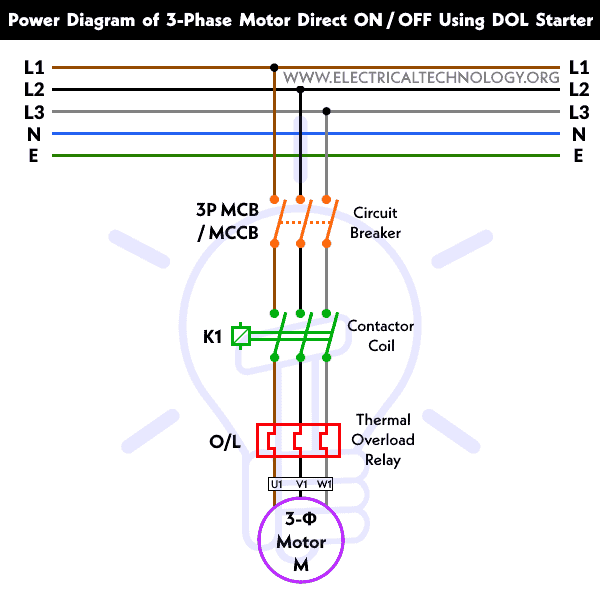How to Start & Stop a 3-Phase Motor from Multiple Locations?
Starting and Stopping a 3-Phase Motor from Multiple Remote Locations
In industrial and commercial applications, it is often necessary to control a 3-phase motor from multiple locations. Whether it’s for convenience, safety, or operational efficiency, the ability to start and stop a motor from different points within a facility can be crucial. In today’s tutorial, we will show how to control the starting and stopping operation of a three-phase motor from different locations using DOL starter and pushbuttons with the help of power and control diagrams.
Basics of 3-Phase Motor Control Circuit
Before diving into multi-location control, it’s essential to understand the fundamental principles of 3-phase motor control. 3-phase motors are commonly used in various industrial processes due to their efficiency and power. The basic control components for a 3-phase motor include:
- Motor Starter: A motor starter is an electromechanical device that controls the motor’s power supply. It typically includes contactors (electromagnetic switches) and overload protection (using thermal O/L Relay) to safeguard the motor against excessive current. Both the contactor and overload relay combined in a box forms a DOL starter.
- Start-Stop Stations: These are the control points where operators can initiate motor start and stop commands. Each station typically consists of a start button, a stop button, and sometimes an emergency stop button for safety.
- Control Circuit: The control circuit connects the start-stop stations to the motor starter. It includes control wires and may incorporate various control devices like relays, timers, and control switches with proper interlocking.
- Related Post: How to Control a 3-Phase Motor from Multiple Places?
Components Required
- Three-Phase Motor
- DOL Starter (Based on Contactor & O/L Relay)
- 2P-MCB and 3-P MCCB
- 3 or More Nos. of ON/OFF Switches
- Single Phase & Three Phase Supply
- Wires & Cables
Power, Control & Wiring Diagrams
The following wiring diagrams show the Starting & Stopping of a three phase motor from different remote locations using DOL starter.
Power Diagram
Control Circuit Diagram
Schematic Control Wiring Diagram
Traditional Single-Location Control
Before discussing multi-location control, let’s briefly review the conventional single-location motor control. In a basic setup, a single start-stop station is directly wired to the motor starter. When the start button is pressed, the control circuit energizes the motor starter’s coil, closing the contactors and allowing power to flow to the motor. Pressing the stop button de-energizes the coil, opening the contactors and stopping the motor.
Methods for Multi-Location Motor Control (Starting & Stopping)
To address these challenges, several methods and technologies are employed for multi-location motor control:
1. Remote Start-Stop Stations
In this approach, remote start-stop stations are installed at various locations within the facility. These stations are wired to a central control panel or motor control center, which houses the motor starter and necessary control components. The central control panel receives input from the remote stations and controls the motor accordingly.
Advantages:
- Centralized control allows for easy interlocking and coordination.
- Wiring distances are minimized, reducing costs and signal degradation.
- Emergency stop buttons can be integrated into each remote station for safety.
Disadvantages:
- Installation and wiring of remote stations and the central control panel can be complex.
- Maintenance may require access to the central control panel.
2. PLC-Based Control
Programmable Logic Controllers (PLCs) are versatile devices used extensively in industrial automation. In multi-location motor control, PLCs can be programmed to receive inputs from various start-stop stations and execute motor control commands.
Advantages:
- Highly flexible and programmable to meet specific control requirements.
- Remote stations can communicate with the PLC via wired or wireless networks.
- Integration with other industrial processes and automation systems is possible.
Disadvantages:
- Initial setup and programming can be time-consuming.
- Requires knowledge of PLC programming.
3. Wireless Control Systems
Advancements in wireless technology have made it possible to implement multi-location motor control without the need for extensive wiring. Wireless control systems use radio frequency (RF) or Wi-Fi communication to transmit control signals to the motor starter.
Advantages:
- No physical wires between control stations and the motor starter.
- Easy scalability – additional control points can be added without major rewiring.
- Suitable for remote or hard-to-reach locations.
Disadvantages:
- Potential for signal interference or disruptions.
- Initial setup and configuration may require specialized knowledge.
4. Human-Machine Interface (HMI)
In modern industrial settings, Human-Machine Interfaces (HMIs) are increasingly used for motor control. These touchscreen interfaces can be placed strategically, allowing operators to control the motor with ease. HMIs are typically integrated with PLCs for advanced control and monitoring.
Advantages:
- Intuitive and user-friendly.
- Supports a wide range of functionalities and customization.
- Provides real-time data and diagnostics.
Disadvantages:
- Higher initial cost due to the need for HMI hardware.
- Requires expertise in HMI programming and integration.
Related Posts:
- ON / OFF Control of a 3-Phase Motor Using a DOL Starter
- ON / OFF 3- Phase Motor Using 8-PIN Relay and DOL Starter
- ON / OFF 3- Phase Motor Using 14-PIN Relay and DOL Starter
- ON / OFF 3- Phase Motor Using 11-PIN Relay and DOL Starter
- Auto & Manual Control of 3-Phase Motor using DOL & Digital Timer
- Reverse-Forward of 3-Phase Motor using DOL Starter
- Auto & Manual Control of 3-Φ Pump Motor using Float Switch
- Automatic & Manual Control of 3-Phase Motor Using Delay Timer
- Automatic ON/OFF Circuit Using Two 8-PIN Timers for 1 & 3-Φ Load
- How to Control a Three-Phase Motor Using a Foot Pedal Switch?
- Compressor Motor Control in Refrigeration Using Soft Starter
- Even More Power & Control Wiring Diagrams










what is the "c"
Contactor Holding Contact .. and we will explain the circuit step by step…
please explain circuit diagram<br />
We will update all the Motor Power & Control diagrams.. Stay tune. Thanks
Dear Wasim Khan,
Appreciated your effort. Please add fuse failure contact and Auto/Man switch also to complete the control circuit. The motor will not be protected from single phasing, if there is no fuse failure contact in control circuit.
I get many information. just keep it up
how to ON off 3 phase induction motor using temperature controller. please explain and draw the diagram
R f waring